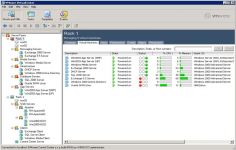 VMware Server 1.0.3
VMware Server 1.0.3
VMware Inc - (Freeware)
VMware Server allows server virtualization by sharing a physical server into multiple virtual machines.
VMware Server is a software based on server virtualization technology for Windows and Linux servers with enterprise-class support. It allows companies to share a physical server into multiple virtual machines.
VMware Server supports Linux and Windows servers for x86 hardware and 64-bit operating systems (Windows, Linux and Solaris), used by single or multi-core processors. This software is also compatible with Intel virtualization technology.
VMware Server is installed as an application and it allows the creation of virtual machines, through an assistant, VMware or Microsoft formats. It increase the CPU utilization of a physical server and it is able to move virtual machines from one physical server to another without re-configuration.
The software can be very easily used even by the inexperienced users.
- Title:
- VMware Server 1.0.3
- File Size:
- 146.1 MB
- Requirements:
- Windows 2000 / XP / Vista / Windows7 / XP64 / Vista64 / Windows7 64 / Windows8 / Windows8 64
- Language:
- en-us
- License:
- Freeware
- Date Added:
- 14 May 2007
- Publisher:
- VMware Inc
- Homepage:
- http://www.vmware.com
- MD5 Checksum:
- F85F10225400DA8313E46DB2DA5DB5AB
Issues Resolved in VMware Server 1.0.3
* This release fixes a problem with VMware Tools that caused the guest to run out of memory.
* VMware Server 1.0.3 fixes a bug introduced in the VMware Server version 1.0.2 VIX API. As a result of this bug, if Vix_ReleaseHandle (vmhandle) and VixHost_Disconnect (hosthandle) are called, a crash occurs in VixHost_Disconnect(). This crash is accompanied by the following error message:
VMware Server Error:
VMware Server unrecoverable error: (app)
ASSERT /build/mts/release/bora-39867/pompeii2005/bora/lib/vmdb/vmdbCtx.c:487 bugNr=23952
A log file is available in "/tmp/vmware-mark/vix-3749.log". Please request support and include the contents of the log file.
To collect files to submit to VMware support, run vm-support.
We will respond on the basis of your support entitlement.
Security Issues Resolved in VMware Server 1.0.3
* Virtual machines can be put in various states of suspension, as specified by the ACPI power management standard. When returning from a sleep state (S2) to the run state (S0), the virtual machine process (VMX) collects information about the last recorded running state for the virtual machine. Under some circumstances, VMX read state information from an incorrect memory location. This issue could be used to complete a successful Denial-of-Service attack where the virtual machine would need to be rebooted.
Thanks to Tavis Ormandy of Google for identifying this issue.
The Common Vulnerabilities and Exposures project (cve.mitre.org) assigned the name CVE- 2007-1337 to this issue.
* Some VMware products support storing configuration information in VMware system files. Under some circumstances, a malicious user could instruct the virtual machine process (VMX) to store malformed data, causing an error. This error could enable a successful Denial-of-Service attack on guest operating systems.
Thanks to Sungard Ixsecurity for identifying this issue.
The Common Vulnerabilities and Exposures project (cve.mitre.org) assigned the name CVE-2007-1877 to this issue.
* Some VMware products managed memory in a way that failed to gracefully handle some general protection faults (GPFs) in Windows guest operating systems. A malicious user could use this vulnerability to crash Windows virtual machines. While this vulnerability could allow an attacker to crash a virtual machine, we do not believe it was possible to escalate privileges or escape virtual containment.
Thanks to Ruben Santamarta of Reversemode for identifying this issue.
The Common Vulnerabilities and Exposures project (cve.mitre.org) assigned the name CVE-2007-1069 to this issue.
* In a 64-bit Windows guest on a 64-bit host, debugging local programs could create system instability. Using a debugger to step into a syscall instruction may corrupt the virtual machine's register context. This corruption produces unpredictable results including corrupted stack pointers, kernel bugchecks, or vmware-vmx process failures.
Thanks to Ken Johnson for identifying this issue.
The Common Vulnerabilities and Exposures project (cve.mitre.org) assigned the name CVE-2007-1876 to this issue.
Related software
2.3/5 from 144 users
